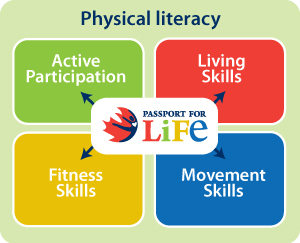Parents’ Guide
Passport for Life was developed by Physical and Health Education Canada (PHE Canada) to support the development and advancement of students’ physical literacy—their ability tomove with competence and confidence in a wide variety of physical activities in multiple environments that benefit the healthy development of the whole person.
Parents play a critical role in helping children develop physical literacy. As your child uses Passport for Life, you can expect your child’s teacher to involve you in helping your child set realistic and achievable goals. Who knows! You may even improve your own physical literacy along the way!

The program is designed to be a motivating and efficient way to provide valuable information and feedback to students and teachers about the progress and attainment of physical literacy. In other words, the program is designed to improve students’ learning and is not intended to be a conclusive or complete evaluation of physical literacy to be used as a grade or award. Passport for life assesses four important components of physical literacy (Active Participation, Living Skills, Fitness Skills and Movement Skills).
Active Participation includes involvement in activities within school and beyond, both organized and unorganized. Children and youth should experience activity in a variety of environments, such as on land, on ice and snow, in water and in air. The Active Participation assessment is a self-report questionnaire that students complete about the variety and frequency of their physical activities.
Living Skills tend to be associated with making healthy active choices that are both beneficial to and respectful of their whole self, others and their environment. The Living Skills section reflects the student’s self-report assessment of skills that enable individuals to succeed in life.
Fitness Skills include balance, muscle endurance and cardiovascular fitness (stamina). The role of education is to build skills in children, to inspire them to act and to develop in them a sense of competence that can be applied to other areas of life. The Fitness Skills section assesses skills in balance/dynamic stability, core muscle endurance and cardiovascular ensurance.
Movement Skills include throwing, jumping, and running—the building blocks of more complex skills used in games, activities, sports and leisure pursuits. The Movement Skills section assesses skills in object manipulation (kicking), object control (throwing and catching), and locomotion (running) - key components of physical literacy.
Students’ results are reported within target ranges (Emerging, Developing, Acquired, or Accomplished) that are aligned to a standard of physical literacy for their age group rather than to each other. These target ranges enable students to improve their:
- awareness about physical literacy - meaning of physical literacy, why it is important to develop physical literacy in order to make healthy lifestyle choices;
- awareness of their own active participation and living, fitness, and movement skills;
- ability to set and meet individualized goals to enhance their physical literacy levels.
